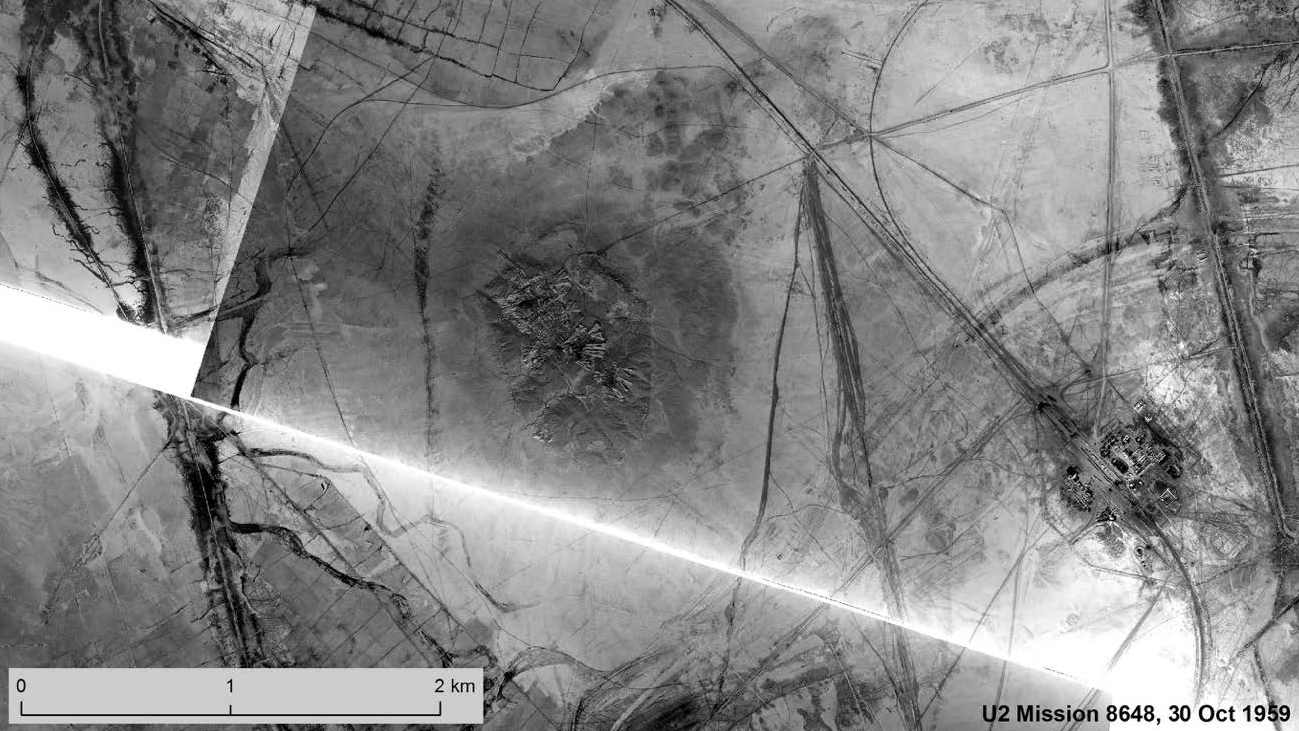U-2 Spy Planes Help Archaeologists Decode the Past in a New Exhibition at the Penn Museum

PHILADELPHIA—A new exhibition at the Penn Museum zooms in on top-secret aerial reconnaissance materials from the Cold War. Opening August 20, 2022, U-2 Spy Planes & Aerial Archaeology uncovers the United States military’s intelligence gathering during the 1950s and 1960s, using the world’s most famous spy plane. Engineered to be lightweight, U-2s soared at altitudes that sometimes allowed them to avoid detection, while a high-resolution camera stealthily filmed military facilities. Unknowingly, they also captured 70,000-foot-high views of ancient archaeological sites and geographic features, with resolutions rivaling images from Google Earth and Bing Maps.
Declassified in 1997, the rolls of black and white negatives gathered in these clandestine operations were available to the public through the National Archives. However, the images were not scanned, indexed, or digitized. There was no way to figure out where the film was shot, or whether photos existed of a specific region.
Through approximately 15 large-scale printed photographs and a selection of objects from the Museum's collections, U-2 Spy Planes & Aerial Archaeology provides a snapshot of the archives that now serve as a unique tool for today’s researchers— yielding new insights into ancient cities, vanished landscapes, prehistoric hunting patterns, and 20th-century rural communities who still engaged in pre-industrial modes of life, before modern development projects transformed or erased them.
U-2 Spy Planes & Aerial Archaeology highlights evidence of kite-shaped hunting traps in eastern Jordan; the watercourses and suburbs of the early Mesopotamian city of Ur; and 1950s marsh villages in southern Iraq. Cameras aboard U-2 planes also documented Aleppo, Raqqa, and Mosul—cities that were later destroyed during the Syrian Civil War and occupation by the Islamic State.
The exhibition’s assets are part of a larger project by researchers from the University of Pennsylvania and Harvard University, who embarked on a mission to reconstruct U2 flight paths and build a spatial index of accessible images.
Dr. Emily Hammer, Assistant Professor in the Department of Near Eastern Languages and Civilizations and the Price Lab for the Digital Humanities at Penn’s School of Arts and Sciences, along with Dr. Jason Ur, the Stephen Phillips Professor of Archaeology and Ethnology at Harvard, sifted through thousands of feet of film. After creating digital copies, they stitched frames together to make the contents easily accessible through a database compiling U-2 flight paths over the Middle East.
Dr. Hammer and Dr. Ur’s work illustrates the importance of these remarkably detailed photographs for the fields of archaeology, anthropology, and history, and allows other researchers to comb through the archives for images that may be relevant to their own areas of study.
“U-2 Spy Planes demonstrates how open-access archival data from the U.S. government can benefit researchers across disciplines, as well as the public,” Dr. Hammer says. “I hope that Museum visitors will have the same exciting feeling of time travel and discovery that I experience in seeing the human-scale details, hidden ancient landscapes, and lost ways of life captured in these decades-old declassified photos.”
Access to U-2 Spy Planes & Aerial Archaeology, on the Museum’s Lower Level in the Merle-Smith Gallery, is included with Penn Museum admission. The special exhibition is scheduled to be on display through Fall 2023.
###
About the Penn Museum
The Penn Museum’s mission is to be a center for inquiry and the ongoing exploration of humanity for our University of Pennsylvania, regional, national, and global communities, following ethical standards and practices.
Through conducting research, stewarding collections, creating learning opportunities, sharing stories, and creating experiences that expand access to archaeology and anthropology, the Museum builds empathy and connections across diverse cultures
The Penn Museum is open Tuesday-Sunday, 10:00 am-5:00 pm. It is open until 8:00 pm on first Wednesdays of the month. The Café is open Tuesday-Thursday, 9:00 am-3:00 pm and Friday and Saturday, 10:00 am-3:00 pm. On Sundays, the Café is open 10:30 am-2:30 pm. For information, visit penn.museum, call 215.898.4000, or follow @PennMuseum on social media.
Curator Bio
Dr. Emily Hammer is an Assistant Professor of Digital Humanities and Archaeology in the Department of Near Eastern Languages and Civilizations and the Price Lab for the Digital Humanities within the University of Pennsylvania’s School of Arts and Sciences. Her expertise lies in landscape archaeology, the study of the spatial organization of past communities and the reconstruction of the environments in which they lived.
She has used archaeological survey, analyses of aerial and satellite imagery, digital mapping, and other tools to study early cities, ancient empires, and pre-modern mobile pastoralists throughout the Middle East, especially in southern Iraq, southeastern Turkey, and Azerbaijan. Her collaborative mapping projects have also addressed the crisis of cultural heritage destruction in Afghanistan and have reconstructed past land use for the purposes of improving long-term climate change modeling.



